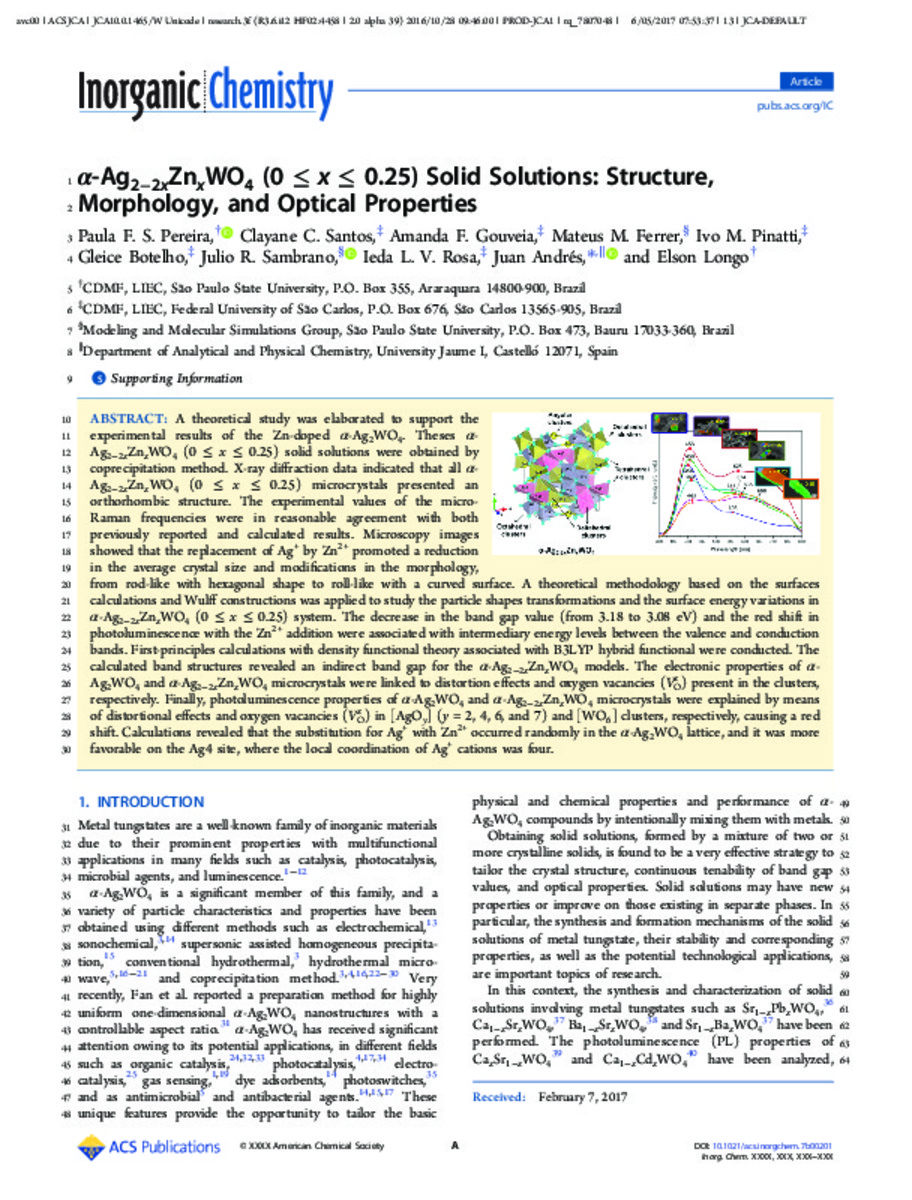Mostrar el registro sencillo del ítem
alpha-Ag2-2xZnxWO4 (0 <= x <= 0.25) Solid Solutions: Structure, Morphology, and Optical Properties
| dc.contributor.author | Pereira, Paula | |
| dc.contributor.author | Santos, Clayane C. | |
| dc.contributor.author | Gouveia, Amanda | |
| dc.contributor.author | Ferrer, Mateus M. | |
| dc.contributor.author | Pinatti, Ivo M | |
| dc.contributor.author | Botelho, Gleice | |
| dc.contributor.author | Sambrano, Julio | |
| dc.contributor.author | Rosa, Ieda | |
| dc.contributor.author | Andres, Juan | |
| dc.contributor.author | Longo, Elson | |
| dc.date.accessioned | 2017-11-09T12:26:49Z | |
| dc.date.available | 2017-11-09T12:26:49Z | |
| dc.date.issued | 2017-06 | |
| dc.identifier.citation | PEREIRA, Paula FS, et al. α-Ag2–2 x Zn x WO4 (0≤ x≤ 0.25) Solid Solutions: Structure, Morphology, and Optical Properties. Inorganic Chemistry, 2017. | ca_CA |
| dc.identifier.uri | http://hdl.handle.net/10234/169963 | |
| dc.description.abstract | A theoretical study was elaborated to support the experimental results of the Zn-doped α-Ag2WO4. Theses α-Ag2–2xZnxWO4 (0 ≤ x ≤ 0.25) solid solutions were obtained by coprecipitation method. X-ray diffraction data indicated that all α-Ag2–2xZnxWO4 (0 ≤ x ≤ 0.25) microcrystals presented an orthorhombic structure. The experimental values of the micro-Raman frequencies were in reasonable agreement with both previously reported and calculated results. Microscopy images showed that the replacement of Ag+ by Zn2+ promoted a reduction in the average crystal size and modifications in the morphology, from rod-like with hexagonal shape to roll-like with a curved surface. A theoretical methodology based on the surfaces calculations and Wulff constructions was applied to study the particle shapes transformations and the surface energy variations in α-Ag2–2xZnxWO4 (0 ≤ x ≤ 0.25) system. The decrease in the band gap value (from 3.18 to 3.08 eV) and the red shift in photoluminescence with the Zn2+ addition were associated with intermediary energy levels between the valence and conduction bands. First-principles calculations with density functional theory associated with B3LYP hybrid functional were conducted. The calculated band structures revealed an indirect band gap for the α-Ag2–2xZnxWO4 models. The electronic properties of α-Ag2WO4 and α-Ag2–2xZnxWO4 microcrystals were linked to distortion effects and oxygen vacancies (VOx) present in the clusters, respectively. Finally, photoluminescence properties of α-Ag2WO4 and α-Ag2–2xZnxWO4 microcrystals were explained by means of distortional effects and oxygen vacancies (VOx) in [AgOy] (y = 2, 4, 6, and 7) and [WO6] clusters, respectively, causing a red shift. Calculations revealed that the substitution for Ag+ with Zn2+ occurred randomly in the α-Ag2WO4 lattice, and it was more favorable on the Ag4 site, where the local coordination of Ag+ cations was four. | ca_CA |
| dc.format.extent | 12 p. | ca_CA |
| dc.format.mimetype | application/pdf | ca_CA |
| dc.language.iso | eng | ca_CA |
| dc.publisher | American Chemical Society | ca_CA |
| dc.rights | Copyright © 2017 American Chemical Society | ca_CA |
| dc.rights.uri | http://rightsstatements.org/vocab/InC/1.0/ | * |
| dc.title | alpha-Ag2-2xZnxWO4 (0 <= x <= 0.25) Solid Solutions: Structure, Morphology, and Optical Properties | ca_CA |
| dc.type | info:eu-repo/semantics/article | ca_CA |
| dc.identifier.doi | http://dx.doi.org/10.1021/acs.inorgchem.7b00201 | |
| dc.relation.projectID | Fundação de Amparo à Pesquisa do Estado de São Paulo (FAPESP 2012/14004-5, 2013/07296-2, 2013/26671-9, 2013/23995-8, 2014/14171-4, and 2016/07476-9) ; Conselho Nacional de Desenvolvimento Cientifíco e Tecnológico (CNPq; 46126-4, 479644/2012-8, 350711/2012-7, 304531/2013-8, and 151136/2013-0); Coordenaca̧õ de Aperfeico̧ amento de Pessoal de Niível Superior (CAPES, 787027/2013, and 8881068492/2014-01) ; Generalitat Valenciana (PrometeoII/2014/022, ACOMP/2014/270, and ACOMP/2015/1202 projects) ; Ministerio de Economía y Competitividad (Spain) (CTQ2015-65207-P) ; Programa de Cooperación Científica con Iberoamerica (Brasil) of Ministerio de Educación (PHBP14-00020) | ca_CA |
| dc.rights.accessRights | info:eu-repo/semantics/openAccess | ca_CA |
| dc.relation.publisherVersion | http://pubs.acs.org/doi/abs/10.1021/acs.inorgchem.7b00201 | ca_CA |
| dc.type.version | info:eu-repo/semantics/acceptedVersion | ca_CA |
Ficheros en el ítem
Este ítem aparece en la(s) siguiente(s) colección(ones)
-
QFA_Articles [817]
Articles de publicacions periòdiques







